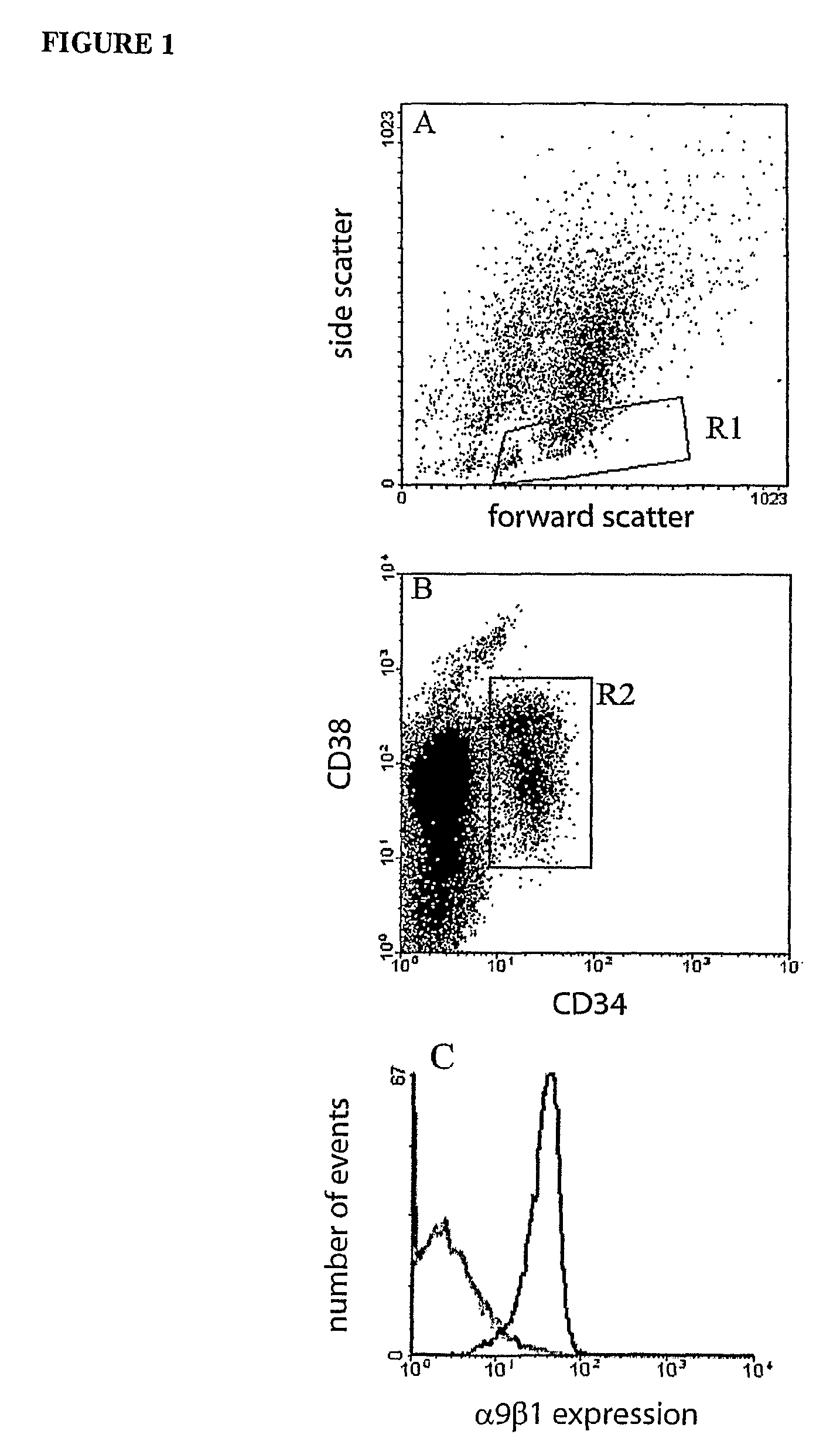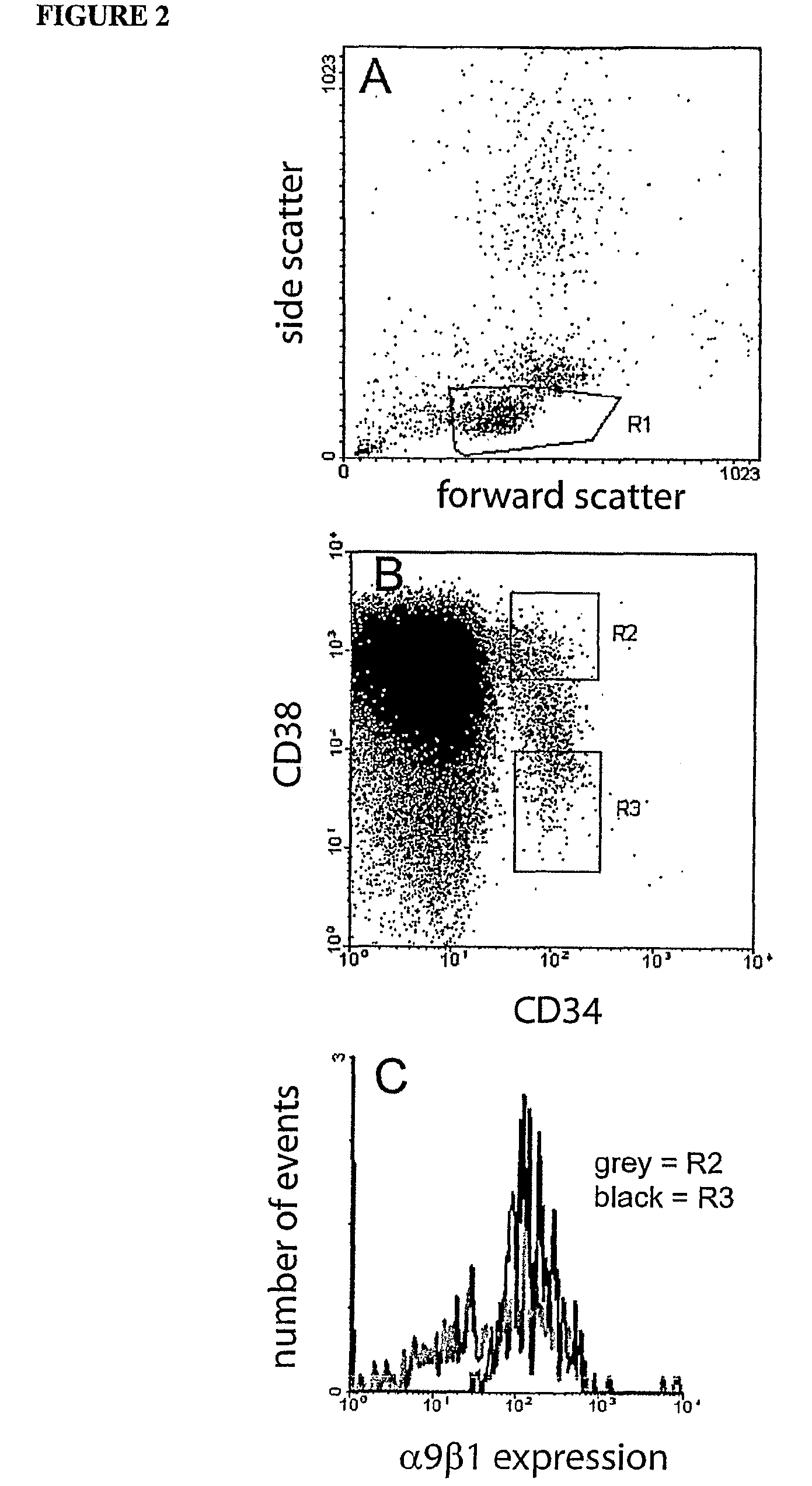Selecting, culturing and creating lineage committed hematopoietic stem cells
a hematopoietic stem cell and culturing technology, applied in the field of hematopoietic stem cell selection, culturing and creating lineage committed hsc, can solve the problems of insufficient stem cells for bone marrow transplantation, inability to define the spatial distribution of hsc within the bone marrow, and inability to adequately address ex vivo hsc. methodologies
- Summary
- Abstract
- Description
- Claims
- Application Information
AI Technical Summary
Benefits of technology
Problems solved by technology
Method used
Image
Examples
example 1
Expression of α9β1 by HSCs
[0134]Cord blood was collected into sodium citrate and held at room temperature (RT) until processed. Low density BM cells were isolated from CD by discontinuous density centrifugation using Ficoll-Hypaque (1.077 g / ml, Pharmacia Biotech, Sweden). A variation of the Dynal bead method for clinical scale selection of cells using the Isolex 300i was used for isolation of CD341 cells. CB mononuclear cells were incubated with anti-CD34, washed and exposed to Dynal anti-mouse IgG beads to rosette CD34+ cells. CD34+ cells were captured and incubated with peptide release agent to isolate CD34+ cells. Cells were immunolabelled with a cocktail of CD34-FITC and CD38-PE (Becton Dickinson) for subsequent isolation of CD34+, CD34+CD38 and CD341CD38+ cells by FACS. α9β1 expression was analysed by co-labelling using an anti-mouse biotin secondary antibody and a strep-avidin Red670 tertiary antibody. Immunolabelled cells were sorted on a FACStarPLUS (Becton Dickinson).
[0135]...
example 2
α9β1 Antibody Significantly Inhibits Human Hematopoiesis in vitro but not as Extensively as Thrombin-Cleaved Opn
[0138]Human cord blood cells were sorted by FACS and plated into cell culture wells (300 cells / well) in the presence of Cellgro supplemented with 6 growth factors G-CSF, CSF, FL-T3 ligand, (FLT3-L), MGDF (all 100 ng / ml), IL-6 and IL-3 (both 10 ng / ml). In addition, α9β1 antibody (Chemicon), thrombin-cleaved bovine Opn (R & D Systems, Minneapolis, Minn., USA), or Opn inhibiting peptide [SVVYGLR-NH2] (Auspep) (SEQ ID NO:1) were added. All cells were cultured at 37° C. in 5% O2, 10% CO2 and 85% N2. Cells were grown for 6 days prior to counting.
[0139]The results are shown in FIG. 3, Cellgro (white bar), α9β1 antibody (black bar), thrombin cleaved bovine Opn (dark grey bar) and the combination of α9β1 antibody with thrombin cleaved bovine Opn (light grey bar).
[0140]After 6 days in culture, cell proliferation of CD34+, CD38−, CB was inhibited in the presence of α9β1 antibody and ...
example 3
An Opn Peptide which Binds to α9β1 Significantly Inhibits Human Hematopoiesis in vitro
[0141]Thrombin-cleaved Opn was prepared by incubating 24 μg bovine Opn in 20 mM Tris-HCl (pH 7.6), 80 mM NaCl, 2 mM CaCl2 and 0.1 units of thrombin (CSL, Parkville, Australia), for 10 min at 37° C. Cleavage or Opn was confirmed by Western blot analysis revealing the 2 expected fragments of approximately 28 and 30 kD.
[0142]Cord blood cells (CD34+, CD38−, HSC) were sorted by fluorescence activated cell sorting (FACS) and plated into cell culture wells (300 cells / well) in the presence of Cellgro supplemented with 6 growth factors (white bar, FIG. 4), thrombin cleaved bovine Opn (black bar), or osteopontin peptide specific to the region revealed post thrombin cleavage (dark grey bar). After 6 days, there was significant inhibition of cell proliferation in the presence of thrombin cleaved bovine Opn and the osteopontin peptide (FIG. 4)
[0143]While the present invention has been described with reference t...
PUM
| Property | Measurement | Unit |
|---|---|---|
| molecular weight | aaaaa | aaaaa |
| molecular weight | aaaaa | aaaaa |
| molecular weight | aaaaa | aaaaa |
Abstract
Description
Claims
Application Information
 Login to View More
Login to View More - R&D
- Intellectual Property
- Life Sciences
- Materials
- Tech Scout
- Unparalleled Data Quality
- Higher Quality Content
- 60% Fewer Hallucinations
Browse by: Latest US Patents, China's latest patents, Technical Efficacy Thesaurus, Application Domain, Technology Topic, Popular Technical Reports.
© 2025 PatSnap. All rights reserved.Legal|Privacy policy|Modern Slavery Act Transparency Statement|Sitemap|About US| Contact US: help@patsnap.com



